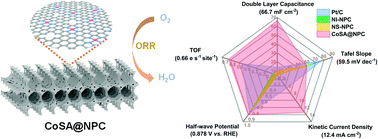Atomically dispersed Co in a cross-channel hierarchical carbon-based electrocatalyst for high-performance oxygen reduction in Zn–air batteries†
Abstract
Rational design of the metal active sites and triple-phase interfaces is essential to enhance the catalytic oxygen reduction reaction (ORR) performance of single atom catalysts (SACs). Yet the exposure and intrinsic activity of the atomic metal sites are still not sufficient and the mass transfer process is also not well optimized. Here, a novel dual-template strategy is created to construct a cross-channel hierarchical CoSA@NPC electrocatalyst with abundant Co–N4 sites, topological carbon defects, and mass-transfer channels. Compared with NI-NPC (no-ice template) and NS-NPC (no-silica template), CoSA@NPC has 7 times higher electrochemical surface area and 11 times higher intrinsic activity in the alkaline medium. The CoSA@NPC based Zn–air battery achieves a high specific capacity of 905 mA h g−1 and maintains superb stability even after 350 hours. Moreover, the results of theoretical calculations prove that abundant defects can effectively optimize the adsorption of Co–N4 active sites on oxygen intermediates, leading to better catalytic activity than pure Co–N4 sites.



 Please wait while we load your content...
Please wait while we load your content...